Wednesday, November 30, 2005
Aljo kettu Värriössä - Tame fox in Varrio station
 Värriön tutkimusaseman ympäristössä asustaa kesy kettu, jonka liikkeitä voi seurata lumien tultua. Lyhyen päivän aikana ruokaa etsivä kettu voi näyttäytyä jo iltapäivällä tutkimusaseman pihalla. Kuva otettu tutkimusaseman laboratoriohuoneen ikkunan läpi.
Värriön tutkimusaseman ympäristössä asustaa kesy kettu, jonka liikkeitä voi seurata lumien tultua. Lyhyen päivän aikana ruokaa etsivä kettu voi näyttäytyä jo iltapäivällä tutkimusaseman pihalla. Kuva otettu tutkimusaseman laboratoriohuoneen ikkunan läpi.A tame fox (Vulpes vulpes) is living in the surroundings of Varrio research stations. The footprints in the snow tell about its movments. In short early winter days the hungry fox is looking for food for the long night and it can sometimes be seen in the late afternoon in the yard of the station. This photo has been taken through the Varrio laboratory window.
Tuesday, November 29, 2005
Rannimmainen Sotatunturi - Foremost Sotatunturi fell
 Marraskuun Värriökuvia: Rannimmainen Sotatunturi. Kauempana kairassa on toinen tunturi, nimeltään Maaimmainen Sotatunturi.
Marraskuun Värriökuvia: Rannimmainen Sotatunturi. Kauempana kairassa on toinen tunturi, nimeltään Maaimmainen Sotatunturi.November photos in Varrio: The Foremost Sotatunturi Fell. There are two sister fells like this, the other one is caller Backmost Sotatunturi fell.
Monday, November 28, 2005
Pitkiä varjoja Lattuna-aavalla - Lond shadows on Lattuna aapa mire
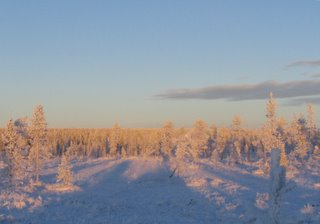 Marraskuun Värriökuvia: Pitkiä varjoja Lattuna-aavalla.
Marraskuun Värriökuvia: Pitkiä varjoja Lattuna-aavalla.November photos in Varrio: Long shadows on Lattuna aapa mire.
Sunday, November 27, 2005
Talvi tuli Värriölle - Winter came to Varrio
Tuli talvi lopulta Itäkairaan - eilen aamulla oli jo 25 cm lunta kepissä, ja tänään on vajaat 10 astetta pakkasta. Vielä toissapäivänä 25.11. oli kaksi viherpeippoa Ainikuusikossa, eilen asemalla kaksi punatulkkua ja urpiaisia. Muuten näyttää olevan vain paikallislintuja - käpylintuja, lapintiaisia, kuukkeleita...
Naarashirvi nähtiin myös toissapäivänä Pitkälläjängällä. TH
Winter came to the Eastern wilderness - finally. Yesterday morning we had already 25 cm snow on the measurement pole, today our temperature was almost -10 degrees. Yet the day before yesterday 25.11. there were two greenfinches (Carduelis chloris) in the forest Ainikuusikko, yesterday there were two bullfinches (Pyrrhula pyrrhula) and redpolls (Carduelis flammea) on the station. Besides these there seem to be only local birds - crossbills (Loxia sp.), Siberian tits (Parus cinctus) and jays (Perisoreus infaustus) ...
We also saw a female moose on the Pitkajanka mire on the day before yesterday.
Наконец пришла и зима на Восточую глухомань - вчера утром было уже 25 см снега в палке, сегодня почти 10 градусов мороза. Еще позавчера 25.11.были две зеленушки в ельнике Аиникуусикко, вчера два снегиря и чечетки на станций. Иначе кажется, что есть только местные птитцы - клесты, лапландские гаички, кукши...
Видели и самку лося позавчера на болоте Питкаянка.
Naarashirvi nähtiin myös toissapäivänä Pitkälläjängällä. TH
Winter came to the Eastern wilderness - finally. Yesterday morning we had already 25 cm snow on the measurement pole, today our temperature was almost -10 degrees. Yet the day before yesterday 25.11. there were two greenfinches (Carduelis chloris) in the forest Ainikuusikko, yesterday there were two bullfinches (Pyrrhula pyrrhula) and redpolls (Carduelis flammea) on the station. Besides these there seem to be only local birds - crossbills (Loxia sp.), Siberian tits (Parus cinctus) and jays (Perisoreus infaustus) ...
We also saw a female moose on the Pitkajanka mire on the day before yesterday.
Наконец пришла и зима на Восточую глухомань - вчера утром было уже 25 см снега в палке, сегодня почти 10 градусов мороза. Еще позавчера 25.11.были две зеленушки в ельнике Аиникуусикко, вчера два снегиря и чечетки на станций. Иначе кажется, что есть только местные птитцы - клесты, лапландские гаички, кукши...
Видели и самку лося позавчера на болоте Питкаянка.
Saturday, November 26, 2005
Sauoiva punaisessa - Sauvoiva fell in November red
Friday, November 25, 2005
Kynttiläkuusia kuparissa - Candle spruces against copperry sky
 Marraskuun Värriökuvia: kynttiläkuusia kuparissa.
Marraskuun Värriökuvia: kynttiläkuusia kuparissa.November photos in Varrio: Candle spruces against coppery sky.
Thursday, November 24, 2005
Väriraitoja etelässä - Color stripes in southern sky

Marraskuun Värriökuvia: Väriraitoja etelässä
November photos in Varrio: Color stripes in southern sky
Wednesday, November 23, 2005
Värriöstä lounaaseen - Southwest of Varrio
Tuesday, November 22, 2005
Sauoiva iltapäivän hämyssä - Sauoiva fell in dim afternoon light
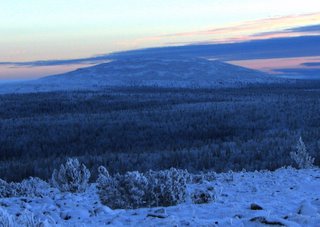 Marraskuun Värriökuvia: Sauoiva iltapäivän hämyssä
Marraskuun Värriökuvia: Sauoiva iltapäivän hämyssäSauoivan massiivi (615 m) hallitsee Värriön luonnonpuiston maisemaa kaikkina vuodenaikoina. Marraskuussa, vähän lumen aikaan Sauoivan kivirakat erottuvat korostuneen selvästi. Kuvan etualalla Värriö II:n itärinnettä.
November photos in Varrio: Sauoiva fell in dim afternoon light.
Massive Sauoiva fell (615 m) dominates the Varrio Nature Reserve scenery in all seasons. In November, during thin snow the stony slopes of the fell are clearly seen, even in dim light. In the forefront of the photo the eastern slope of Varrio II fell is seen.
Monday, November 21, 2005
Rakitsanjänkä sinisessä - Rakitsanjanka mire in blue
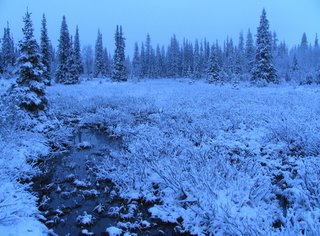 Marraskuun Värriökuvia: Rakitsanjänkä sinisessä
Marraskuun Värriökuvia: Rakitsanjänkä sinisessäMarraskuun - alkavan kaamoksen - väri on sininen, kuten tässä Rakitsanjängältä otetussa kuvassa. Rakitsanjänkä on satulassa Värriötuntureiden ja Rakitsanvaaran välissä. Satulasuolta laskee kaksi puroa vastakkaisiin suuntaan: pohjoisen puro Kuntasjokeen ja eteläinen puro Hirvasjokeen.
November photos in Varrio: Rakitsanjanka mire in blue.
The colour of November is blue, except short moments on clear sky when the Sun still shines. Rakitsanjanka mire - here in blue - is a wetland in the saddle between Varrio fells and Rakitsa hill. The small creeks flow to opposite sites from the saddle mire. One creek is flowing to north, to Kuntas river. The other creek is flowing to south, to Hirvas river.
Sunday, November 20, 2005
Lumilinjojen hiihto alkaa - Skiing of snow depth monitoring tracks begins
 Normaalisti marraskuun puolivälissä alkaa Värriön tutkimusasemalla alkaa lumilinjojen hiihto. Lumen syvyyttä ja eläin liikehdintää (jälkien perusteella) seurataan kerran viikossa maastoon pysyvästi merkityillä kahdella linjalla. Pitkä lumilinja on noin 8 kilometrin mittainen, Värriö I:n laelta alas Ylinuorttijoen laaksoon. Linjalla on 200 mittauspistettä. Oheen lasketusta talven 1987-1988 mallikuvasta näkyy keskimääräinen lumensyvys, ja miten se muuttui talven aikana. Tälle ja muillekin vuosille on tyypillistä kuvaajan vinous: lumi tulee syyspuolella hitaammin kuin mitä se sulaa kevätpuolella. Huippu saavutetaan maaliskuun lopulla.
Normaalisti marraskuun puolivälissä alkaa Värriön tutkimusasemalla alkaa lumilinjojen hiihto. Lumen syvyyttä ja eläin liikehdintää (jälkien perusteella) seurataan kerran viikossa maastoon pysyvästi merkityillä kahdella linjalla. Pitkä lumilinja on noin 8 kilometrin mittainen, Värriö I:n laelta alas Ylinuorttijoen laaksoon. Linjalla on 200 mittauspistettä. Oheen lasketusta talven 1987-1988 mallikuvasta näkyy keskimääräinen lumensyvys, ja miten se muuttui talven aikana. Tälle ja muillekin vuosille on tyypillistä kuvaajan vinous: lumi tulee syyspuolella hitaammin kuin mitä se sulaa kevätpuolella. Huippu saavutetaan maaliskuun lopulla.Weekly monitoring of snow depth and movements of animals (based on tracks and traces in the snow) starts around mid November. There are two permanent monintoring lines in the Varrio reserve. The long snow-line starts from the top of Varrio I fell, and stretches 8 km down to Ylinuortti river valley. On the the way there are 200 permanent observation poles. In the model graph above from the winter 1987-1988 we can see pattern of snow depth. A certain skewness can be seen in this graph, as well as in the graphs for other winter. The building up of the snow cover in early winter is slower than the melting of the snow in spring. The maximum snow depth takes places around end of March.
Saturday, November 19, 2005
Valoilmiö Värriötunturissa - Light phenomenon above Varrio fells
 Marraskuun Värriökuvia: Valoilmiö Värriötunturissa
Marraskuun Värriökuvia: Valoilmiö VärriötunturissaMarraskuun loppupuolella, keskipäivällä, aurinko nousee vielä etelän suunnassa Värriötuntureiden yläpuolelle, mutta päivän pituus vähenee nyt nopeasti. Kuva Rakitsan vaaralta, äärimmäisenä vasemmalla Värriö III:n laki, siitä oikealla Värriön huippu numero 2.
November photos in Varrio: Light phenomenon above Varrio fells
In the latter half of November, in the middle of the day, the sun is still rising in the south over the Varrio fells. The day length, however, is now shortening rapidly. The photo has been taken from Rakitsa hill, to left the top of Varrio III, in the middle the top number 2 of the Varrio fells is seen.
Friday, November 18, 2005
Nuorttitunturi marrasauringossa - Nuorttitunturi fell in November sun
 Marraskuun Värriökuvia: Nuorttitunturi marrasauringossa
Marraskuun Värriökuvia: Nuorttitunturi marrasauringossaHarvoina marraskuun aurinkoisina päivinä, ensilumen jo ollessa maassa, Nuorttitunturin laki hohtaa valkoisena Värriötuntureille. Kuvan etualalla Värriö I:n koivuvyöhyke, ja välissä Kotovaaran mäntyä kasvava outamaa. Pakkasta kuvanottohetkellä oli -5 astetta.
November photos in Varrio: Nuorttitunturi fell in November sun.
In the few sunny November days, when the first snow already covers the ground, the top of Nuorttitunturi fell shines as white when looking from Varrio fells. In the front of the photo the birch belt (region subalpina) has thick cover of frozen dew. In the middle the belt of Scots pine in Kotovaara is seen. The temperature while taking the photo, was -5 degrees.
Thursday, November 17, 2005
Kuu nousee huurteisten koivujen takaa - Moon is rising behind frozen dew covered birches
 Tämän, Värriö I:n itälaidalta Nuorttitunturin suuntaan otetun kuvan ottajan on syytä nöyränä tunnustaa, että kuvakulman ja kuvan otsikon taustalla on Kittilän suuren maalarin Reidar Särestöniemen samanniminen taulu. Digikuva on silti vain kalpea aavistus tunnelmasta, jonka Särestöniemi tauluunsa maalasi.
Tämän, Värriö I:n itälaidalta Nuorttitunturin suuntaan otetun kuvan ottajan on syytä nöyränä tunnustaa, että kuvakulman ja kuvan otsikon taustalla on Kittilän suuren maalarin Reidar Särestöniemen samanniminen taulu. Digikuva on silti vain kalpea aavistus tunnelmasta, jonka Särestöniemi tauluunsa maalasi.Its is fair to humbly admit that the model behind the scope and title of this photo is the painting of the famous painter Mr Reidar Sarestoniemi from Kittila, Finnish Lapland. The digital photo, taken from the eastern side of Varrio I fell, towards Nuorttitunturi fell, has however only a meager glimpse of the magic feeling of the moon rise that Mr. Sarestoniemi managed to create in his extraordinary painting.
Wednesday, November 16, 2005
Rakitsa ja Pulkkatunturi marrashuurteessa - Rakitsa hill and Pulkkatunturi fell in frozen dew
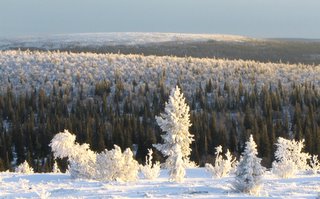 Marraskuun ensilumi tulee usein vahvana huurteena vaarojen ja tunturien lakipuihin. Se johtuu lounaisista kosteista tuulista, jotka tulevat Pohjanlahden ja Perämeren suunnasta, alijäähtyvät noustessaan ilmakehässä ylöspäin. Huurre ja myöhemmin tykky syntyvät ensin korkeille maille, kuten Värriötuntureiden vedenjakajaselänteelle. Kuva Värriö I:n itärinteeltä, yli Rakitsan vaaran, kohti Pulkkatunturia.
Marraskuun ensilumi tulee usein vahvana huurteena vaarojen ja tunturien lakipuihin. Se johtuu lounaisista kosteista tuulista, jotka tulevat Pohjanlahden ja Perämeren suunnasta, alijäähtyvät noustessaan ilmakehässä ylöspäin. Huurre ja myöhemmin tykky syntyvät ensin korkeille maille, kuten Värriötuntureiden vedenjakajaselänteelle. Kuva Värriö I:n itärinteeltä, yli Rakitsan vaaran, kohti Pulkkatunturia.The first snow in November comes oftern as thick frozen dew on tops of hills and fells. The phenomenon results from moist south-western winds that blow over open Gulf of Bothnia. The moist winds form supercool clouds when they rise higher in the nearer atmosphere. Frozen dew and later heavy frozen dew (Finnish: tykky) appear first in higher altitude areas, like the Varrio divide. The photo is taken from Varrio I fell towards east, over Rakitsa hill to Pulkkatunturi fell.
Tuesday, November 15, 2005
Huurre syntyy lakimäntyyn - Frozen dew in Scots pine
 Kun alijäähtyneet pilvet pyyhkivät pakkasella yli tunturin laen, jo vuorokaudessa harvakseltaan kasvaviin puihin syntyy paksu huurre. Tällaisessa säätilanteessa alijäähtynyttä vettä ei ole vielä riittävästi lumikiteiden syntymiseen. Alijäähtynyt vesi tiivistyy sen sijaan huurteeksi törmätessään tunturin laella sopivaan tiivistymisytimeen - lakimäntyyn. Kuva Värriö I:ltä luoteeseen.
Kun alijäähtyneet pilvet pyyhkivät pakkasella yli tunturin laen, jo vuorokaudessa harvakseltaan kasvaviin puihin syntyy paksu huurre. Tällaisessa säätilanteessa alijäähtynyttä vettä ei ole vielä riittävästi lumikiteiden syntymiseen. Alijäähtynyt vesi tiivistyy sen sijaan huurteeksi törmätessään tunturin laella sopivaan tiivistymisytimeen - lakimäntyyn. Kuva Värriö I:ltä luoteeseen.When the supercool clouds sweep in minus temperatures over the fell top, a remarkable layer of frozen dew is formed onto the trees that are growing as scattered near to the top. In a weather situation like this there is not enough water and condensation nuclei in the air for formation of snow. Instead, upon colliding the tree top the supercool water in the clouds condenses into frozen dew, like in the case of Scots pine in the photo. The photo was taken on top of Varrio I fell, towards north-west.
Monday, November 14, 2005
Riukupyrstöt liikkeellä - Long-tailed tits on the move
Matkalla asemalta Savukoskelle aamupäivällä 14.11.05 näin pyrstötiaisia kolmessa paikassa: Sotajoen kämpän W-puolitse lensi auton edestä parvi 7-8 yks. klo 10:30 suuntaan NW. Luiron kohdalla kuulin ääntä pysähtyessäni tien varrella klo 11:05. Pari km N Hihnavaarasta lensi taas auton edestä ainakin 4 yks. parvi klo 11:20, suunta NW-W.
Savukoskella oli melko huonokuntoinen räkättirastas. TH
Driving from the station to Savukoski in the morning 14.11.05 I saw Long-tailed tits (Aegithalos caudatus) in three places: over the road by the car flew a flock of 7-8 birds at 10:30 to NW near to the earlier house of timber workers of the river Sotajoki. Near to the houses of Luiro village I heard the voice when stopping by the road at 11:05. A couple of kilometres to N from the houses of Hihnavaara again I saw a flock of them flying in front of the car to NW-W at 11:20, this time at least 4 birds.
At Savukoski I saw a Fieldfare (Turdus pilaris) in quite bad condition. TH.
На дороге от станций до Савукоски утром 14.11.05 я видел длиннохвостых синиц (ополовников) в трех местах: через дорогу пред машиной пролетел стай 7-8 особей недалеко от бывшего барака лесорубов на реке Сотайоки в 10.30 ч. на северо-западном направление. Около домов Луиро я слышал звук, когда остановился в 11.05 ч. Пару км на север от домов Хихнаваара опять видел стай не меньше 4 особей, летавшие через дорогу на северо-запад-запад в 11.20 ч.
В Савукоски был виден дроздь-рябинник в довольно плохом поряадке.
Savukoskella oli melko huonokuntoinen räkättirastas. TH
Driving from the station to Savukoski in the morning 14.11.05 I saw Long-tailed tits (Aegithalos caudatus) in three places: over the road by the car flew a flock of 7-8 birds at 10:30 to NW near to the earlier house of timber workers of the river Sotajoki. Near to the houses of Luiro village I heard the voice when stopping by the road at 11:05. A couple of kilometres to N from the houses of Hihnavaara again I saw a flock of them flying in front of the car to NW-W at 11:20, this time at least 4 birds.
At Savukoski I saw a Fieldfare (Turdus pilaris) in quite bad condition. TH.
На дороге от станций до Савукоски утром 14.11.05 я видел длиннохвостых синиц (ополовников) в трех местах: через дорогу пред машиной пролетел стай 7-8 особей недалеко от бывшего барака лесорубов на реке Сотайоки в 10.30 ч. на северо-западном направление. Около домов Луиро я слышал звук, когда остановился в 11.05 ч. Пару км на север от домов Хихнаваара опять видел стай не меньше 4 особей, летавшие через дорогу на северо-запад-запад в 11.20 ч.
В Савукоски был виден дроздь-рябинник в довольно плохом поряадке.
Alijäähtyneitä pilviä Pulkkatunturissa - Supercool clouds in Pulkkatunturi fell
 Värriötuntureiden lakimaita pyyhkivät alijäähtyneet pilvet. Tilanne on otollinen huurteen muodostumiselle. Kuva Rakitsan vaarasta itään Pulkkatunturille.
Värriötuntureiden lakimaita pyyhkivät alijäähtyneet pilvet. Tilanne on otollinen huurteen muodostumiselle. Kuva Rakitsan vaarasta itään Pulkkatunturille.Supercool clouds sweep the tops of the Varrio fells. This is a suitable condition for formation of frozen dew in the trees. The photo is taken from Rakitsa hill to east, towards Pulkkatunturi fell.
Sunday, November 13, 2005
Lippu salkoon isäinpäivänä - Official Finnish flag is raised on Fathers' Day

Teuvo Hietajärvi (vasemmalla) ja Esa Laurila nostivat lipun Värriön tutkimusaseman salkoon Isäinpäivän aamuna. Lumet olivat taas lähes sulaneet edellisenä yönä.

Mr. Teuvo Hietajarvi (to the left) and Mr. Esa Laurila raised the official Finnish flag in the morning of the Finnish national holiday "Fathers' Day". As it is seen in the pictures, the snows had almost disappeared during the previous night.
Saturday, November 12, 2005
Pirunkurun alalampi jäätymässä - Lower pond in Devil's creek getting ice
 Kotovaaran ja Jyppyrävaaran välisessä Pirunkurussa on kolme lampea. Alimman lammen (kuvassa) pohjoispäässä kulkee Sompion paliskunnan ja Sallan pohjoisen paliskunnan välinen poroaita. Alalampea ympäröivät kuusikkorinteet ovat sinipyrstön (Tarsiger cyanurus) biotooppia, missä se on tavattu viimeksi kesäkuussa 2003.
Kotovaaran ja Jyppyrävaaran välisessä Pirunkurussa on kolme lampea. Alimman lammen (kuvassa) pohjoispäässä kulkee Sompion paliskunnan ja Sallan pohjoisen paliskunnan välinen poroaita. Alalampea ympäröivät kuusikkorinteet ovat sinipyrstön (Tarsiger cyanurus) biotooppia, missä se on tavattu viimeksi kesäkuussa 2003.The Devil's creek between Kotovaara and Jyppyravaara hill has three ponds. The lowest of them (in the photo), is surrounded by old Norway spruce forest. This forest is a suitable biotope for Red-flanked bluetail (Tarsiger cyanurus), where it was observed for the latest time in June 2003.
Friday, November 11, 2005
Metson 12 matkan pää - End of track, Capercaillie 12
 Vuodesta 1998 Värrön tutkimusasemalla on asennettu radiolähetin (panta) yhteensä 85 maastosta häkkiloukulla pyydetylle metsolle. Samalla metsot on rengastettu. Metso 12 tuli tiensä päähän 11.1.2005. Se löytyi kuolleena Kuntasjoen länsipuolelta. Kettu oli ilmeisesti onnistunut yllättämään vanhan urosmetson 4-5 päivää aikaisemmin, tai metso oli kuollut vanhuuttaan, ja kettu oli sen heti löytänyt. Se oli käynyt syömässä metsoa useita kertoja ennenkuin tutkimusavustaja Sampo Ollila löysi raadon vielä toimivan radiolähettimen signaalin avulla. Hän toi metson tutkimusasemalle, jossa se tutkittiin läpikotaisin, nilkkarengas poistettiin, ja radiolähetin irroitettiin odottamaan tulevia uusia pyyntejä. Metson raato vietiin sen jälkeen tarkkailuhaaskaksi hangelle tutkimusaseman takapihalle. Sieltä metson löysi ruoakseen kärppä (kuvassa). Metso 12 palautui näin Värriön luonnonpuiston kiertoon.
Vuodesta 1998 Värrön tutkimusasemalla on asennettu radiolähetin (panta) yhteensä 85 maastosta häkkiloukulla pyydetylle metsolle. Samalla metsot on rengastettu. Metso 12 tuli tiensä päähän 11.1.2005. Se löytyi kuolleena Kuntasjoen länsipuolelta. Kettu oli ilmeisesti onnistunut yllättämään vanhan urosmetson 4-5 päivää aikaisemmin, tai metso oli kuollut vanhuuttaan, ja kettu oli sen heti löytänyt. Se oli käynyt syömässä metsoa useita kertoja ennenkuin tutkimusavustaja Sampo Ollila löysi raadon vielä toimivan radiolähettimen signaalin avulla. Hän toi metson tutkimusasemalle, jossa se tutkittiin läpikotaisin, nilkkarengas poistettiin, ja radiolähetin irroitettiin odottamaan tulevia uusia pyyntejä. Metson raato vietiin sen jälkeen tarkkailuhaaskaksi hangelle tutkimusaseman takapihalle. Sieltä metson löysi ruoakseen kärppä (kuvassa). Metso 12 palautui näin Värriön luonnonpuiston kiertoon.Metso 12 pyydettiin ensimmäisen kerran 6.5.1998 Hirvasjoen itäpuolella rajavyöhykkeellä sijaitsevalla soidinsuolla. Kenttämestari Kaarlo Koskinen asensi sille radiopannan (lähettimen) kaulaan ja numeroidun alumiinirenkaan nilkkaan. Tulevina vuosina metso 12:stä tehtiin paljon havaintoja. Kotimaisemastaan, Hirvasjoen laaksosta se ei radiopeilausten mukaan poistunut koskaan. Sille vaihdettiin uusi radiolähetin keväällä 2000. Viimeisen kerran metso 12 pyydystettiin keväällä 2004, se sai uuden radiolähettimen ja samalla se punnittiin. Vanhalla ukolla oli painoa 3777 grammaa. Ikääntyminen oli alkanut jo pudottaa sen painoa. Erkki Pulliainen totesi, että "Värriön alueella raavas metso painaa tyypillisesti vähän yli neljä kiloa, mutta vanhetessaan lintu alkaa pienetä. Esimerkiksi tutkimusmetso numero 12 näyttäisi painon perusteella oleen kuollessaan 10-15 -vuotias. Sen elimistö oli alkanut rappeutua ja elämä käydä raskaaksi."
Loppuvuonna 2005 metso 12 sai lisäarvoa. Sen rengastusikä ensimmäisestä loukkupyynnistä viimeiseen löytymiseen oli 6 vuotta 8 kuukautta 5 päivää. Juuri ilmestynyt Rengastajan vuosikirja 2005 kertoo, että rengastusiältään Suomen vanhin metso oli tähän asti 6 v 2kk 24 p, eli Värriön metsovanhus ottaa Suomen ennätyksen haltuunsa.
Aiheesta myös: Sipola, T. Värriön aineisto on ainutlaatuista. Ympäristö 7/2005:29-31, ja Rengastajan vuosikirja 2005, s. 50.
Since 1998 altogether 85 Caperciallies (Tetrao urogallus) in the surroundings of Varrio research station have been equipped with radio transmitters. The birds had been captured in wintertime with a trap that has been developed in the station. During the capture the birds also got an ordinary numbered aluminium ring, used in in bird ringing.
Capercaillie number 12, an old male, was found dead on 11 January 2005 on the western bank of Kuntas river. Based on the traces on the snowy ground it seemed that a fox had managed to attack the capercaillie and kill it 4-5 days earlier. Or it may have happened that the old bird had just died and the fox had immeidately found the carcass.
The fox had eaten the carcass several timed before the research assistant of the station, Mr. Sampo Ollila traced the dead bird as the radio transmitter kept sending the signal. He brought the Capercaillie to the station. The bird was examined, the radio transmitter was removed and the numbered ring was released. Afterwards the carcass of the Capercaillie was placed outside in the snow in the backyard of the station, for carcass monitoring. It was soon found by hermelin (in the photo) that started to eat the carcass. Thus Capercaillie 12 slowly returned to the eternal cycle of matter in the Varrio nature reserve.
Capercaillie 12 was captured for the first time on 6 May 1998 east of Hirvas river. The research technician, Mr. Kaarlo Koskinen installed the first radio transmitter and ringed the bird. In the coming years great many observations were done on the movements of the bird. It was remarkable that the bird was very faithful to its home area; it never moved away from Hirvas river creek and the nearby forests. Anew transmitter was installed in spring 2000 and the last one in spring 2004.
During the last capture the weight of the old male bird was 3777 grams. It had passed the top weight. Professor Erkki Pulliainen has noted that full-grown male caopercaillies in Varrio weigh typically a little over four kilograms. The Capercaillie No 12 had started to loose its weight, and based on this its age is 10-15 years. It is high age for capercaillie, and it is no wonder if it had just died because of its age, or if it had weakened so that that the fox managed to capture it.
In late 2005 the capercaillie 12 got another merit. The recent annual report of Finnish bird ringing noted that so far the longest ringing period for a ringed capercaillie has been 6 years 2 months and 24 days. The oldie of Varrio hit the record. The period between the original ringing and the final release of the ring was 6 years 8 months and 5 days. The Capercaillie 12 is thus the Finnish champion in its field.
Two interesting (Finnish) references tell more about the topics: 1) Sipola, T. Värriön aineisto on ainutlaatuista. Ympäristö 7/2005:29-31, and 2) Rengastajan vuosikirja 2005, p. 50.
Thursday, November 10, 2005
Viimeiset väriläiskät - the last autumn color spots
 Värriön luonnonpuiston lumettomasta, kaamosajan maasta löytyy enää harvoja väriläiskiä. Näkyvin niistä on kellanvihreä Pohjolan korvajäkälä (Nephroma arcticum). Se kuuluu nahkajäkälien lahkoon (Peltigerales). Pohjolan korvajäkälä on verraten yleinen Värriössä. Kuvan yksilö kasvaa Kotovaarassa.
Värriön luonnonpuiston lumettomasta, kaamosajan maasta löytyy enää harvoja väriläiskiä. Näkyvin niistä on kellanvihreä Pohjolan korvajäkälä (Nephroma arcticum). Se kuuluu nahkajäkälien lahkoon (Peltigerales). Pohjolan korvajäkälä on verraten yleinen Värriössä. Kuvan yksilö kasvaa Kotovaarassa.In snowless November forest of Varrio reserve only few colored spots are found. The brightest of them is the Arctic kidney lichen (Nephroma arcticum). It belongs to the order Peltigerales. Arctic kidney lichen is rather common in Varrio reserve. This specimen grows in Kotovaara hill.
Pilkukas nahkajäkälä - Green dog lichen
 Toinen tumman maan väriläiskä on pilkukas nahkajäkälä (Peltigera aphthosa). Sekin kuuluu nahkajäkäliin. Pilkukas nahkajäkälä on Värriön luonnonpuistossa huomattavasti harvalukuisempi kuin Pohjolan korvajäkälä.
Toinen tumman maan väriläiskä on pilkukas nahkajäkälä (Peltigera aphthosa). Sekin kuuluu nahkajäkäliin. Pilkukas nahkajäkälä on Värriön luonnonpuistossa huomattavasti harvalukuisempi kuin Pohjolan korvajäkälä.The other colored spot in the dark November ground is the Green dog lichen (Peltigera aphthosa). It belongs to Peltegrales, too. In Varrio nature reserve Green dog lichen is remarkably rarer than than Arctic kidney lichen.
Wednesday, November 09, 2005
Lumet taas kertaalleen lähteneet - Snow disappeared again
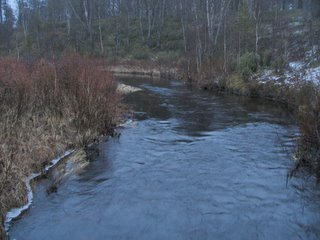 Värriön luonnonpuistossa vuoden 2005 ensilumi on tullut jo kolmeen kertaan - ja sulanut myös kolmeen kertaan. Kun viime päivät on satanut silkkaa vettä myös Ylinuortti virtaa ääriään myöten täynnä. Kuva kesäsillalta ylävirtaan 9.11.2005 klo 15.
Värriön luonnonpuistossa vuoden 2005 ensilumi on tullut jo kolmeen kertaan - ja sulanut myös kolmeen kertaan. Kun viime päivät on satanut silkkaa vettä myös Ylinuortti virtaa ääriään myöten täynnä. Kuva kesäsillalta ylävirtaan 9.11.2005 klo 15.The first snow of 2005 has come already three times - and also melted three times. As it has been raining rather heavily during the last days also Ylinuortti river flows full of water, near to its flooging level. The photo is from the summmer track brigde, up the river, taken on 9 Nov 2005 at 15 hours.
Tuesday, November 08, 2005
Värriön tutkimusasema marraskuussa - Varrio research station in November
 Marraskuussa Värriön tutkimusaseman kenttätoiminta on hiljaisimmallaan: kesäopiskelijat ovat lähteneet, fotosynteesiin kyvettimittaus on pysäytetty talven ajaksi ja muu Smear-mittaus jatkuu automaattisena, hyönteisten valorysäpyynti on pysäytetty. Eläinten talvihavannoinnin aloitus odottaa lumipeitettä. Sulan maan aikana kerätyn aineiston analysointi ja tallennus ovat tämän kauden toimia.
Marraskuussa Värriön tutkimusaseman kenttätoiminta on hiljaisimmallaan: kesäopiskelijat ovat lähteneet, fotosynteesiin kyvettimittaus on pysäytetty talven ajaksi ja muu Smear-mittaus jatkuu automaattisena, hyönteisten valorysäpyynti on pysäytetty. Eläinten talvihavannoinnin aloitus odottaa lumipeitettä. Sulan maan aikana kerätyn aineiston analysointi ja tallennus ovat tämän kauden toimia.In November the field activities of Varrio research station are at their minimum. Summertime students habe returned to their universities. Fotosynthesis (couvette) measurements have been ceased for winter time; the other Smear measurements are fully automatic. Light trap research of insects has been stopped in the coldening weather. The winter monitoring of animal tracks waits for snow cover. The research material that has been collected during thye growing season will be analyzed and input into computers during this period.
Monday, November 07, 2005
Kuutsjärvi, saunajärvi - Lake Kuutsjarvi with sauna
 Tutkimusaseman alapuolella oleva Kuutsjärvi - saunajärvi - jäätyi 23.10.2005. Kuvassa rantasauna syystalven asussa. Tutkimusaseman päärakennus ylhäällä portaiden päässä. Kuntasjoki virtaa kuvan oikean laidan kuruun.
Tutkimusaseman alapuolella oleva Kuutsjärvi - saunajärvi - jäätyi 23.10.2005. Kuvassa rantasauna syystalven asussa. Tutkimusaseman päärakennus ylhäällä portaiden päässä. Kuntasjoki virtaa kuvan oikean laidan kuruun.Lake Kuutsjarvi, below the research station (to the upper left in the picture) got the ice cover on 23 October 2005. The Finnish sauna (in the centre) is part of the research station. Kuntas river flows from the lake to Kuntas creek (on the right in the picture).
Sunday, November 06, 2005
Naltiotunturi marraskuussa - Naltio fell in November
 Marraskuussa, vähäisten lumien aikaan, harvoina aurinkoisina päivinä, UKK-puistossa olevan Naltiotunturin laki erottuu vielä muuten tummasta maisemasta.
Marraskuussa, vähäisten lumien aikaan, harvoina aurinkoisina päivinä, UKK-puistossa olevan Naltiotunturin laki erottuu vielä muuten tummasta maisemasta.In November, during the first snows, on rare sunny days, the top of Naltio fell is clearly seen against the dark wilderness. Naltio fell (north of Varrio) belongs to Urho Kekkonen National Park.
Saturday, November 05, 2005
Millainen lumitalvi tullee? - What might be the expected snow cover pattern?
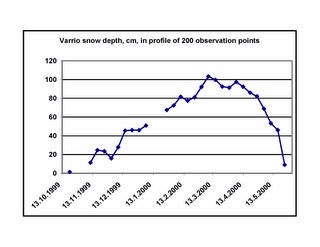
Värriön tutkimusaseman talviajan tärkeitä havaintoja ovat lumensyyvydet, jotka kirjataan viikottain, joka keskiviikko hiihdettäviltä lumilinjoilta. Lokakuussa 2005 lumilinja ehdittiin hiihtää kerran, mutta lumi suli sitten. Näin kävi myös kuvan mallitalvena 1999-2000. Se oli kova talvi, silloin 200 havaintopisteen keskiarvo ylitti maaliskuussa yhden metrin rajan.
Some of the most important observation series in Varrio are the weekly (every Wednesday) recorded snow depth. This is done by skiing through observation line of some 8 km and recording the snow depth in 200 observation points. In October 2005 the snow line was oberved already once, but then the snow melted. This happened also in the model winter of the graph, 1999-2000. It was a very good year, with snow depth exceeding one meter in March.
Friday, November 04, 2005
Kaamospolku Värriötunturiin - November track to Varrio Nature Reserve
 Talvipolku Värriötunturiin ennen pysyvää lunta voi olla illan suussa varsin väritön. Kuva Pitkäjängältä.
Talvipolku Värriötunturiin ennen pysyvää lunta voi olla illan suussa varsin väritön. Kuva Pitkäjängältä.November track to Varrio Nature Reserve can be rather colorless. Phot from Pitkajanka mire.
Thursday, November 03, 2005
Ylinuortti talvisillalta - River Ylinuortti from winter bridge
 Soiden jäätyessä kulku Värriön tutkimusasemalle siirtyy kesäpolulta talvipolulle. Talvipolku ylittää Ylinuortin Nuorttiaavalla; kuva talvipolun sillalta.
Soiden jäätyessä kulku Värriön tutkimusasemalle siirtyy kesäpolulta talvipolulle. Talvipolku ylittää Ylinuortin Nuorttiaavalla; kuva talvipolun sillalta.When the soil and mires get frozen the travelling path to Varrio station changes from summer track into winter track. The winter track crosses the river Ylinuortti in Nuorttijanka aapa mire.
Wednesday, November 02, 2005
Poron matkanpää - End of reindeer´s track
Löysin tänään Rakitsanjängän laidalta nuoren poron jäännökset. Jokin oli tykännyt poronlihasta. Nahka ja luita oli enää jäljellä, tapaus ei ollut vanha. Korppeja on lennellyt viime aikoina aseman ympäristössä. Raatoja saattaa olla muitakin. TH
I found today the remains of young reindeer at the mire Rakitsanjänkä. Someone (or something) did like reindeer meat. There were only skin and bones left, this was not an old case. We have seen Common ravens (Corvus corax) flying near the station in recent times. There can be other carrions, too. TH.
2.11.05 я нашел остатки молодого оленья на окраине болота Ракитсанянка. Кто-то любил оленину. Только кожа и косты остались, это не старый случай. Мы же видели летающих воронов в прошлые времена близко станций, т.е. там может быть и другие падалы.
I found today the remains of young reindeer at the mire Rakitsanjänkä. Someone (or something) did like reindeer meat. There were only skin and bones left, this was not an old case. We have seen Common ravens (Corvus corax) flying near the station in recent times. There can be other carrions, too. TH.
2.11.05 я нашел остатки молодого оленья на окраине болота Ракитсанянка. Кто-то любил оленину. Только кожа и косты остались, это не старый случай. Мы же видели летающих воронов в прошлые времена близко станций, т.е. там может быть и другие падалы.
Tuesday, November 01, 2005
Punatulkkuja ym. - Bullfinches and other observations
Lumet ovat häipyneet, lämpötila + 5 astetta. Aamukahdeksan jälkeen tutkimusaseman pihalta lähti punatulkkupari, myös talitiainen oli ilmaantunut paikalle. Kotiorava tirskutti pesäpuussaan, jotain suussaan.
Klo. 11:55 Vedenjakajalla kuului viherpeipon ääntä. Kanahaukka ohitti Vedenjakajan eteläpuolelta klo 12.
Klo 12:10. Itäpuoleisen muristan päältä löytyi hiiripöllö, ominaista sille: kuusen latvasta.TH
Snow has gone, the temperature is + 5 degrees. After 8 o'clock a pair of bullfinches (Pyrrhula pyrrhula) flew away from the yard of the station. There was also one Great tit (Parus major). The home-squirrel was chirping on the tree of its nest, something in his mouth.
At 11:55 o'clock I heard the voice of greenfinch (Carduelis chloris).
Northern goshawk (Accipiter gentilis) was flying to the north-west on the east side of Vedenjakaja at 12.
At 12:10 I saw on the hill east of Vedenjakaja Hawk owl (Surnia ulula) at the top of Norway spruce, characteristic to the species. TH.
Наблюдения 1.11.05: Снег растаял, + 5 градусов. После утренного восьми улетела пара снегиря с двора станций, откуда-то появилась и большая синица на месте. Белка-подруга пищала на его домашной дереве, что-то имея во рту.
В 11.55 ч. слышал звук зеленушки на водоразделе Веденякая (30.10. она слышна в ельнике Аиникуусикко).
Ястреб-тетеревятник пролетел на северо-запад на восточной стороне Веденякая в 12. ч.
На сопке на восток от Веденякая был виден Ястребиная сова в 12.10 ч., как своист-венно ему, на вершине елки.
Klo. 11:55 Vedenjakajalla kuului viherpeipon ääntä. Kanahaukka ohitti Vedenjakajan eteläpuolelta klo 12.
Klo 12:10. Itäpuoleisen muristan päältä löytyi hiiripöllö, ominaista sille: kuusen latvasta.TH
Snow has gone, the temperature is + 5 degrees. After 8 o'clock a pair of bullfinches (Pyrrhula pyrrhula) flew away from the yard of the station. There was also one Great tit (Parus major). The home-squirrel was chirping on the tree of its nest, something in his mouth.
At 11:55 o'clock I heard the voice of greenfinch (Carduelis chloris).
Northern goshawk (Accipiter gentilis) was flying to the north-west on the east side of Vedenjakaja at 12.
At 12:10 I saw on the hill east of Vedenjakaja Hawk owl (Surnia ulula) at the top of Norway spruce, characteristic to the species. TH.
Наблюдения 1.11.05: Снег растаял, + 5 градусов. После утренного восьми улетела пара снегиря с двора станций, откуда-то появилась и большая синица на месте. Белка-подруга пищала на его домашной дереве, что-то имея во рту.
В 11.55 ч. слышал звук зеленушки на водоразделе Веденякая (30.10. она слышна в ельнике Аиникуусикко).
Ястреб-тетеревятник пролетел на северо-запад на восточной стороне Веденякая в 12. ч.
На сопке на восток от Веденякая был виден Ястребиная сова в 12.10 ч., как своист-венно ему, на вершине елки.

